Does the CRC Evapo-Rust Really Work?

.png)
The CRC Evapo-Rust is a best-seller for many reasons. We’re guessing many of you will agree but allow us to dig deeper into the topic for the benefit of those who do not.
In this article, we answer these questions:
- What’s your opinion about the product?
- Does the CRC Evapo-Rust really work?
- How does it work?
- How much do I need to use?
- Do I need to fully submerge the whole item, or just the rusted surfaces?
- Will it corrode the rusted metal and other non-metal components?
- How long do I need to soak the rusted metal in it?
- Do I need to sand or scrub the rusted item after soaking it in?
- Can I reuse the liquid solution?
- Is it flammable?
- Is it harmful, hazardous and toxic?
- Feedback from users in real-life applications
Disclaimer: The information compiled here is based on actual experience and diligent research. Nevertheless, it should not be treated as professional advice. As always, read the label and proceed with caution.
What’s your opinion about the product?
One Friday afternoon, our in-house product specialist, Sam C, soaked a bunch of rusted sprockets into pure Evapo-Rust solution. He took photos of his progress of what happened after soaking them (1) after two hours and (2) over the weekend.
(He also brought a pair of pliers riddled with saltwater rust, which we also covered further below.)
Quick verdict: Evapo-Rust works! Rusts gone.
Here are the rusted sprockets before soaking. As you can see, some of them are heavily rusted on the surface, while some are not:
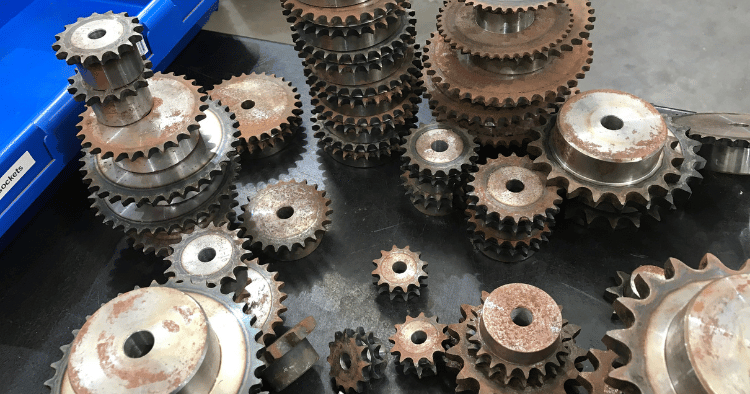
Here they are after being soaked in pure Evapo-Rust after two hours:
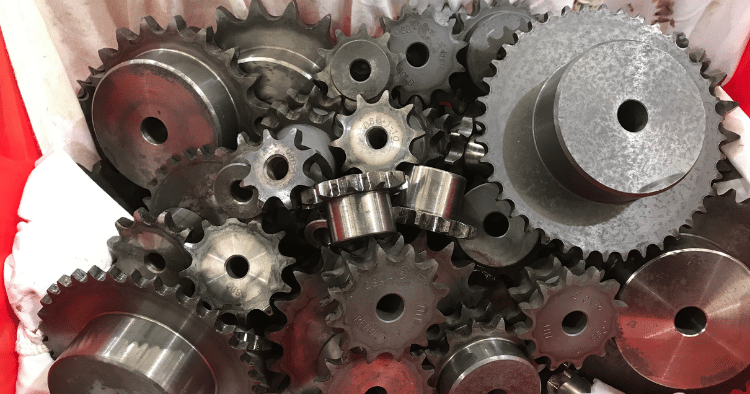
Comparison of the “untreated” (top-half) and “treated” (bottom-half) after being soaked for two hours:
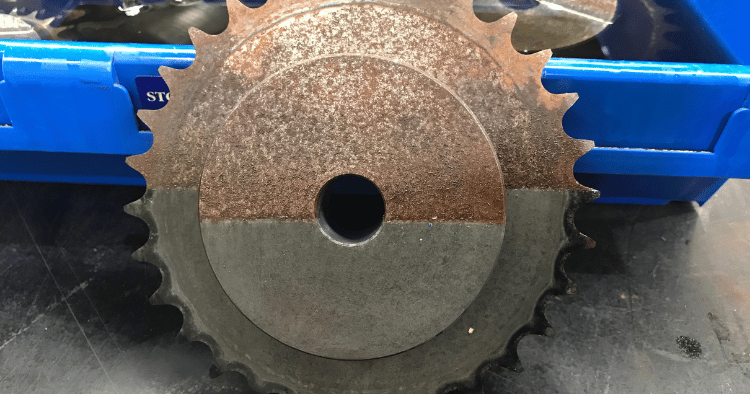
Here they are after being soaked into pure Evapo-Rust over the weekend:

Most came off visibly “rust-free” after some thorough wiping, although Sam had to lightly steel-brush a few ones “to speed up the process” and get the same rust-free result.
According to Sam:
“I used CRC Evapo-Rust with some great results. The photos are time-lapse as well to show the different results. In short, the longer we leave product in solution, the better the results.”
“Rusty sprockets will pose a problem if they are installed as they are. They will work, but the addition of grease will contaminate the lubricant and add to chain and sprocket wear. The trick is to keep the lubricant clear of any contaminants and prolonging the life of all wearing parts. Rust also destroys surface hardness and will accelerate wear."
Does the CRC Evapo-Rust really work?
The quick answer is a yes. It is designed to do one job -- remove rust -- and it does it well, provided, of course, that you use it properly and according to instruction.
Here’s the CRC Evapo-Rust in action:
It “effectively removes even deep rust on all types of mild steels and iron”.
According to the technical data sheet, you should use the product as follows:
- Pre-clean item to remove oil and dirt.
- Rinse item and immerse item fully in Evapo-Rust for 20 minutes.
- Check progress periodically.
- Once rust is removed, rinse the item with water.
- To prevent re-rusting, simply dip the item back in Evapo-Rust solution and allow it to dry.
Note: Deeply rusted parts (5 mm or deeper) may require overnight soaking. Evapo-Rust can be used over and over until performance drops off. When ready to dispose of spent solution, only the iron content of the solution will dictate disposal method. In most cases, it can be safely put down the drain.
How does it work?
EVAPO-RUST® works through selective chelation. This is a process in which a large synthetic molecule forms a bond with metals and holds them in solution. Most chelating agents bind many different metals. The active ingredient in EVAPO-RUST® bonds to iron exclusively. It can remove iron from iron oxide but is too weak to remove iron from steel where the iron is held much more strongly. Once the chelating agent has removed the iron, a sulfur-bearing organic molecule pulls the iron away from the chelator and forms a ferric sulfate complex which remains water soluble. This frees the chelating agent to remove more iron from rust.
More tips from the technical data sheet c/o crceurope.com:
- If Evapo-Rust is used below 15°C, cleaning times will be extended.
- Warmer temperatures will improve rust removal capabilities.
- Store cool (above 0°C) and dry.
How much do I need to use?
That depends a lot on:
- Which product you are using: the spray gel or the liquid solution
- How many items you want to de-rust
- How rusted are the items in question
- How long you "soak” the items in its chemical
While both the spray gel and liquid solution basically have the same formulation, the spray gel “clings” to the surface of the item in question so there’s no need to soak it.
If you have the liquid solution, use it pure and undiluted. It’s ready to use right off the bottle, and there is no need to mix with water.
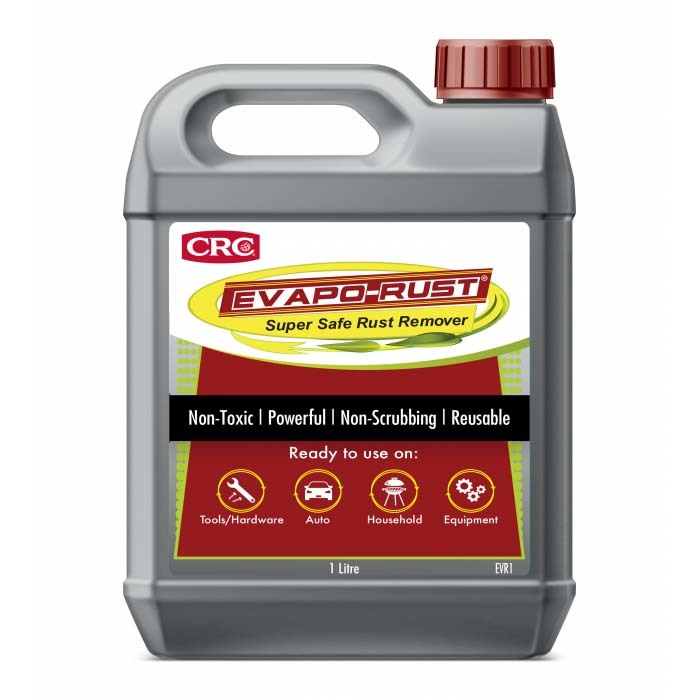 In Sam’s experiment, he took a 5-litre Evapo-Rust solution container to fully submerge around 100 kilograms of sprockets of various sizes. (Fun fact: According to Microsoft Word, 100 kilograms is around the weight of an average professional basketball player.)
In Sam’s experiment, he took a 5-litre Evapo-Rust solution container to fully submerge around 100 kilograms of sprockets of various sizes. (Fun fact: According to Microsoft Word, 100 kilograms is around the weight of an average professional basketball player.)
Sam said he was able to “salvage back in the container about ¾ of the Evapo-Rust solution”.
Do I need to fully submerge the whole item, or just the rusted surfaces?
You only need to submerge the rusted areas. If the whole item is badly rusted all over, then yes, you’ll want to submerge it altogether, especially if it’s badly eaten by rust just like the tools and components in this video by CRC NZ:
Will it corrode the rusted metal and other non-metal components?
The Evapo-Rust is safe to use on (not harmful to):
- Aluminium
- Brass
- Copper
- Non-oxide-based paints
- Plastics
- PVCs
- Rubber
- Vinyl
In fact, Sam has another example, this time with his rusty pliers -- that he uses for fishing, so it is riddled with saltwater rust -- that are seized up and wouldn't spring open. After soaking them in 're-used' Evapo-Rust solution for two hours a soaking and a some mild cleaning up with a wire brush, he was happy with the result:
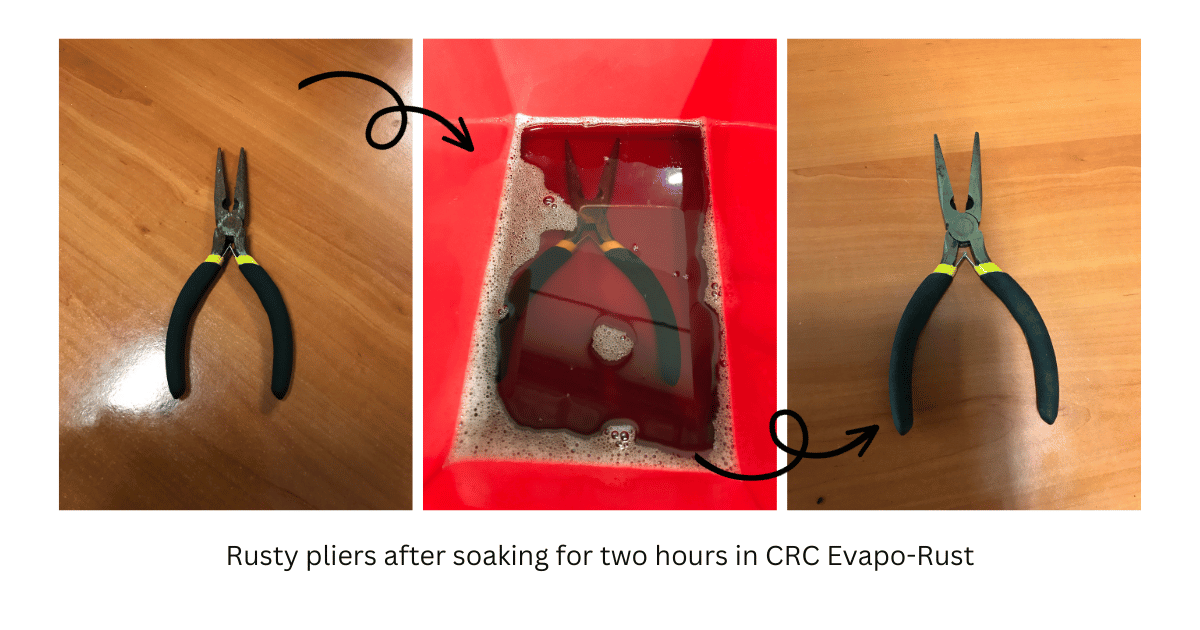
How long do I need to soak the rusted metal in it?
That depends a lot on how badly rusted parts are.
In Sam’s experiment, the sprockets’ surfaces were significantly “rust-free” after a two-hour soak in pure Evapo-Rust but note that they are not heavily rusted to begin with. (He waited it out for another two days.)
Do I need to sand or scrub the rusted item after soaking it in?
Sam had to lightly brush off a few sprockets to achieve the desired result.
Can I reuse the liquid solution?
According to CRC’s video above, the technical data sheet and Sam's pliers example, yes you can reuse the solution “until the performance drops off”.
Is it flammable?
It is “non-caustic”, “non-flammable” and “contains no flammable materials”. We reckon the same is true for the liquid solution. However, keep in mind that it’s still a chemical product best kept away from obvious heat sources and open flames.
Is it harmful, hazardous and toxic?
Please use common sense and observe safety precautions when using the product, but for the record:
- According to the backside label of both the spray gel and liquid solution, they are “not classified as toxic material”, do not contain “acids, alkalis and petroleum” and are not harmful to the user and the environment.
- According to the safety data sheets of both the spray gel and liquid solution, they are “not classified as hazardous” as per Safe Work Australia criteria.
- According to the technical data sheet, they are “safe to use” and contain “no acids, hazardous air pollutants (HAPs) and volatile organic compounds (VOCs)”.
- Both have no strong fumes and odours that can cause irritation under normal conditions. Of course, it’s always best to take extra precautions if you have relevant pre-existing allergies and respiratory conditions.
- It has no food safety certification, although you can use it on parts of food equipment as long as it doesn’t directly come into contact with the food itself. Make sure to wash it off and dry completely before use.
Feedback: Ken H from Perth shared his experience with the CRC Evapo-Rust:
"I have used it on a couple of things, and have had brilliant results. I have just restored two old motorcycles to "as new" condition, and for most of the components a wire buff or grit blasting worked well. But there are a few components which were too delicate for that. One in particular was the tool box on my 1963 A10 BSA.
The sheet steel it is made from is too old/delicate to use grit blasting. The corners and confines make the wire wheel either inaccessible, or dangerous, as it catches on edges. Any acidic medium (if left too long) would dissolve it. Now, these tool boxes are NO LONGER AVAILABLE. They make them in India, and they are either poor quality or just don't fit. Too hit and miss. A second hand one in terrible condition (worse than mine was) sells for $300 - $400 AUD.
So I HAD to save mine.
Evapo-Rust was safe, and can be left as long as you like, as it DOES NOT DISSOLVE BASE METAL.
The greatest point to remember is that Evapo-Rust saturates during use, and it does not convect / self-circulate. So, it will turn black (in areas close to the rust surface) as it absorbs rust, and then stays there against the surface / will not absorb any more. Once saturated, it is no longer of any use = dispose of it.
The best way is to either "stir / circulate" the liquid, or (in a corner where the liquid is "black" and thus saturated) drawn off with a syringe and disposed of / allow unsaturated liquid to continue to work.
See the attached pictures. Before and after:
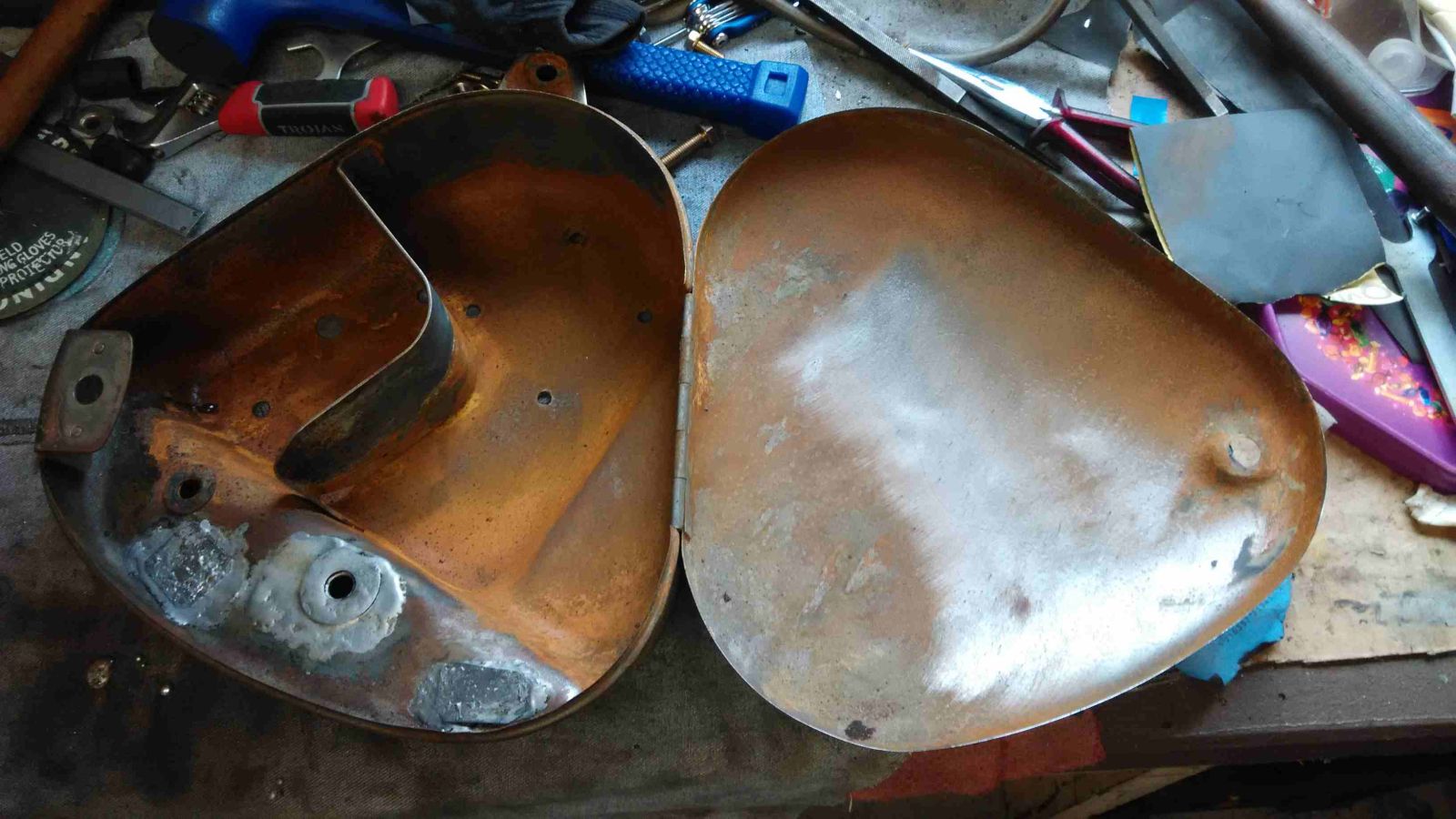
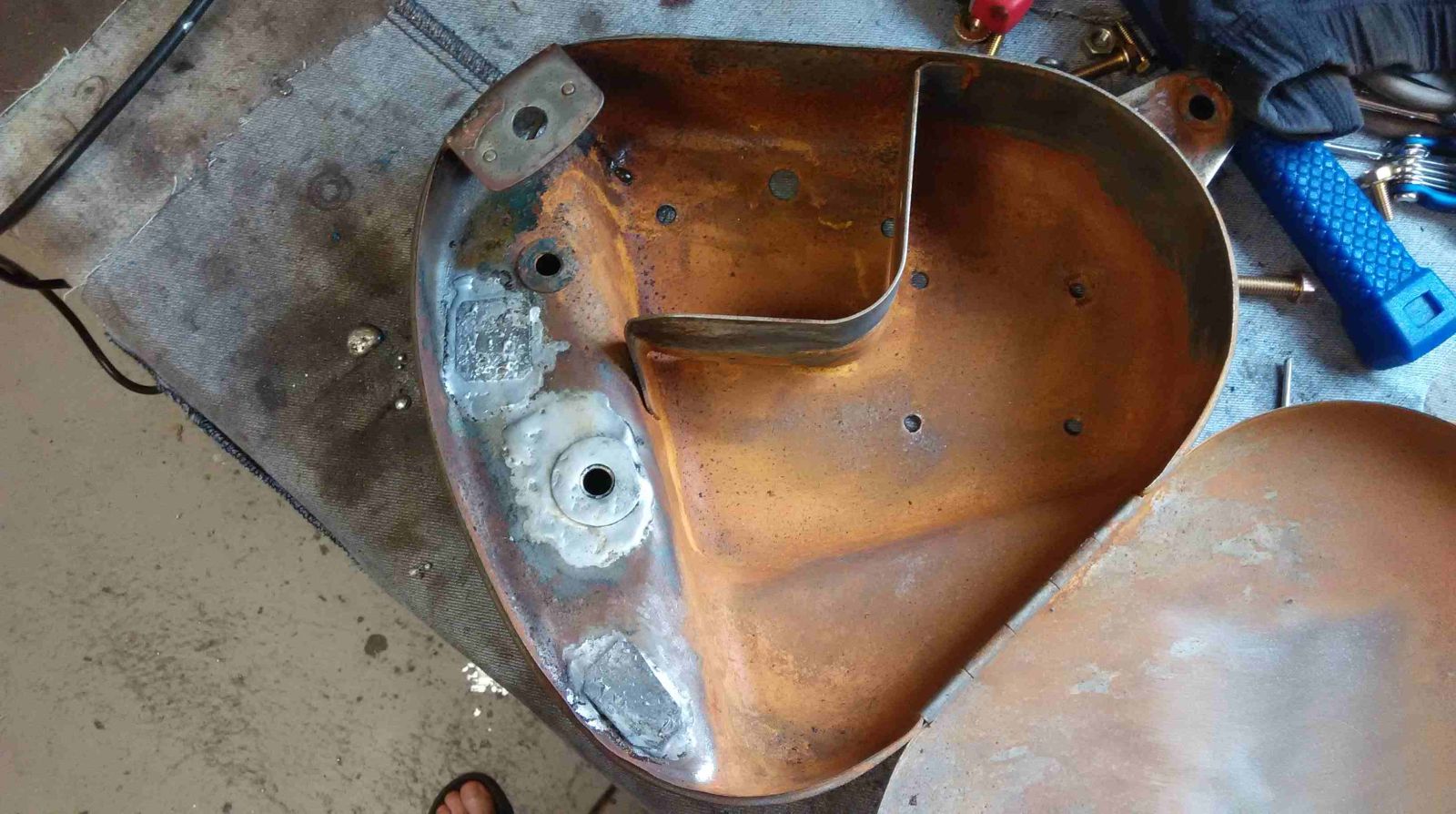
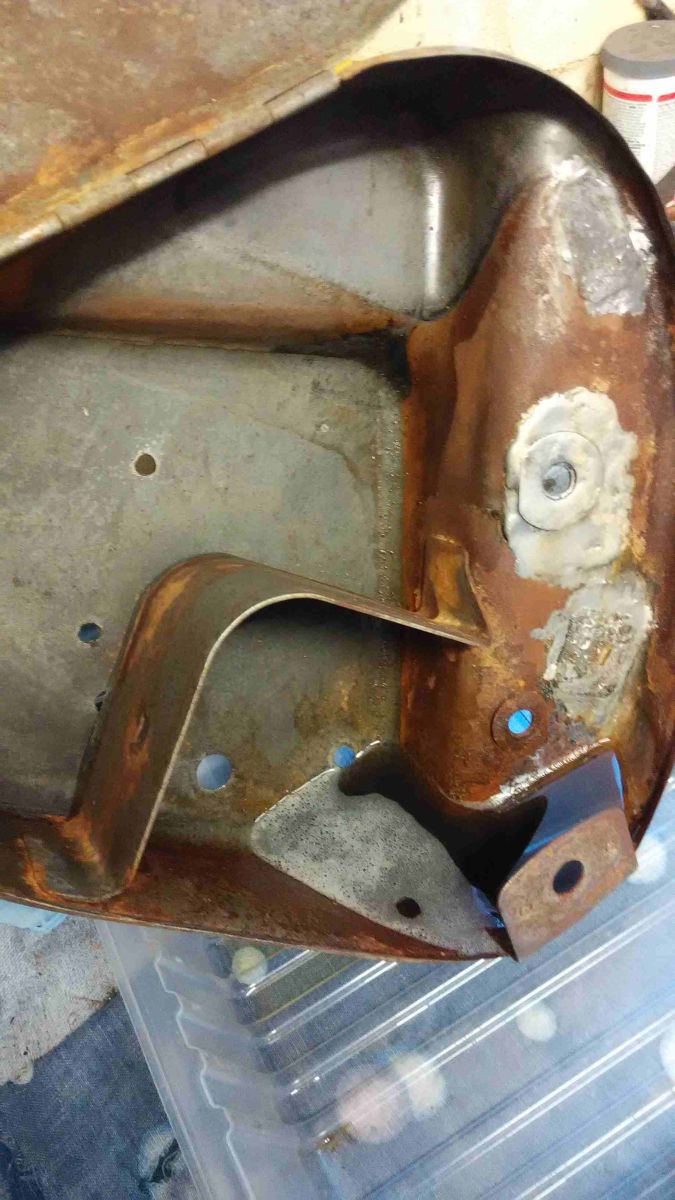
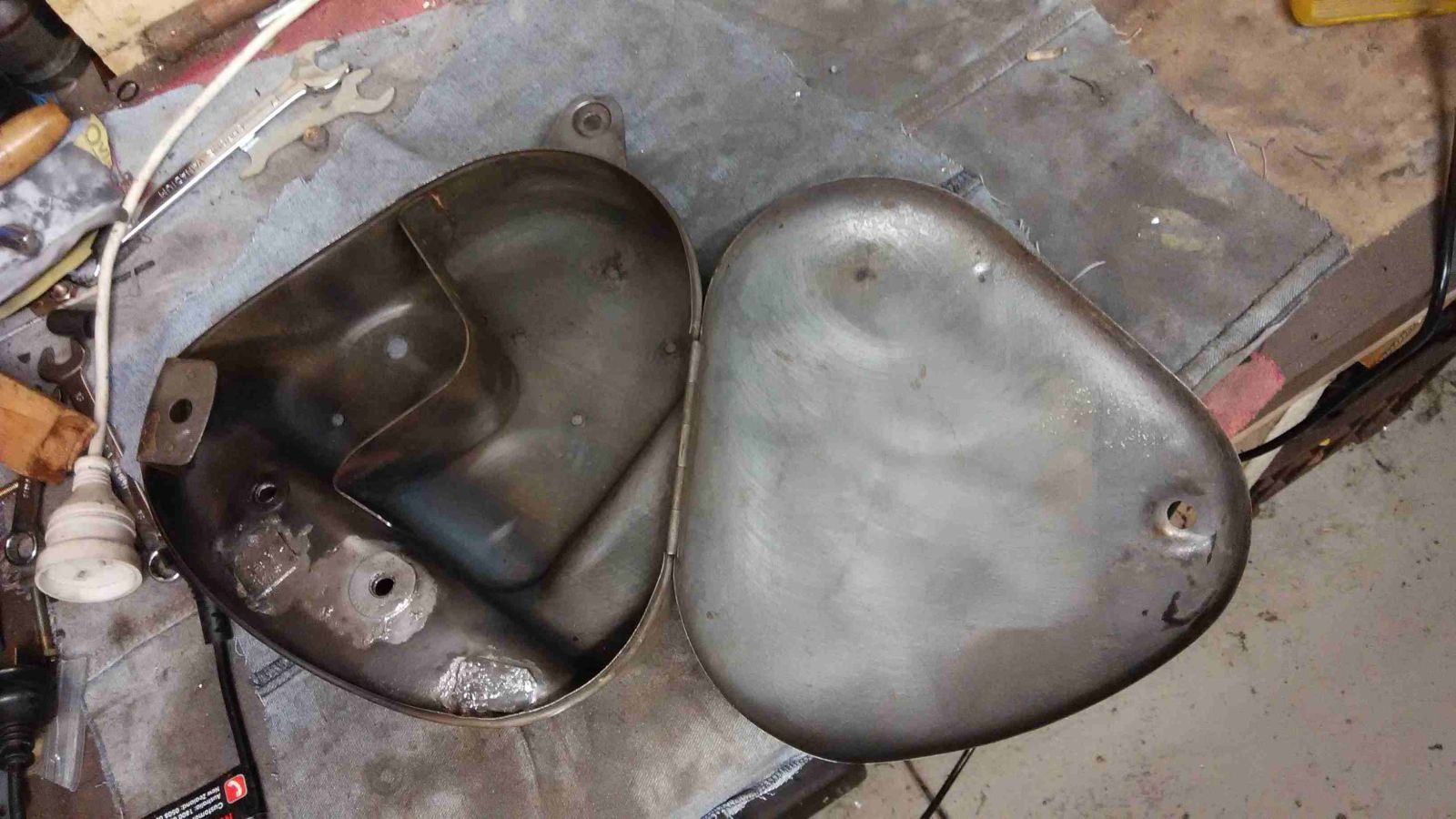
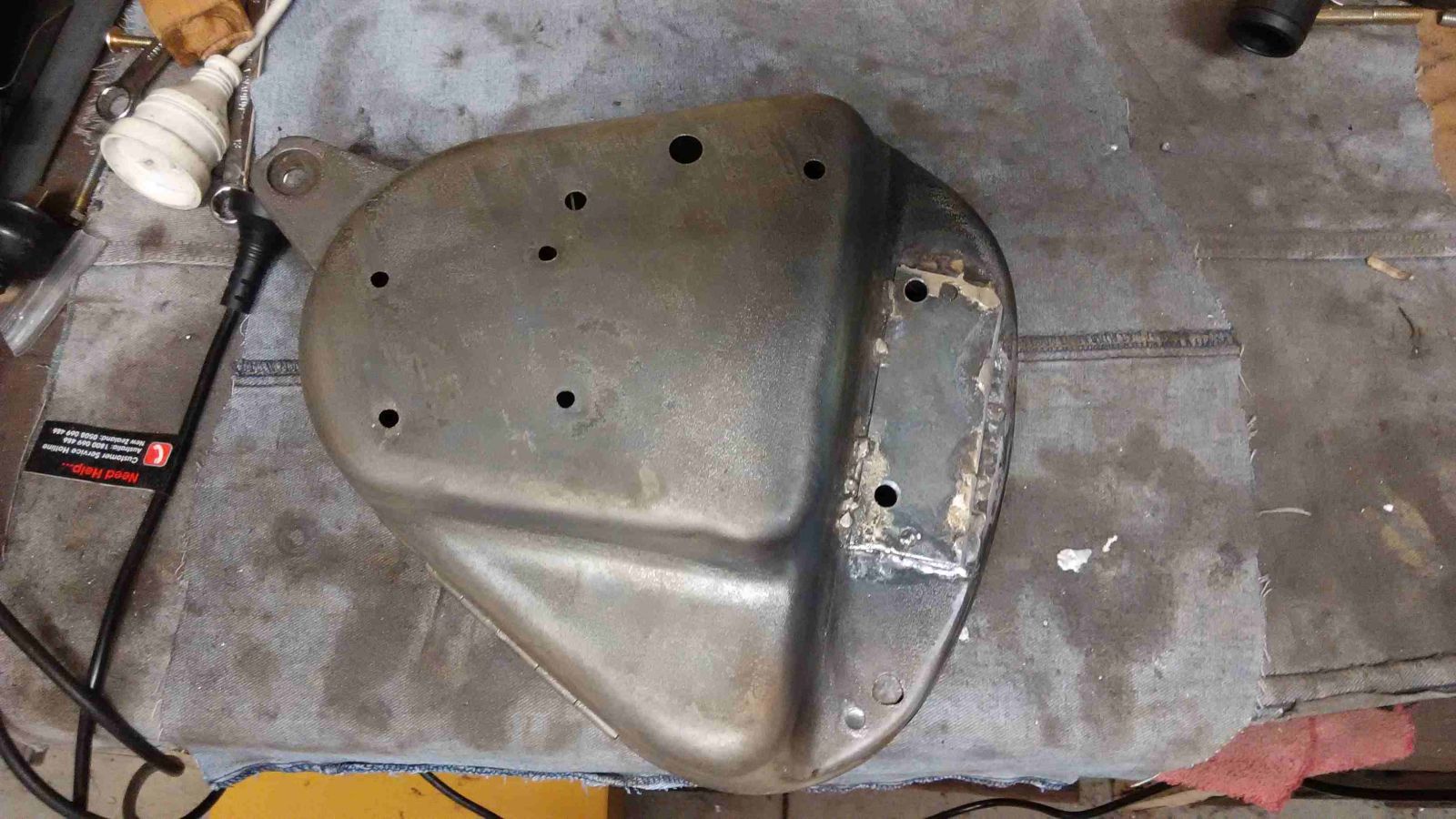
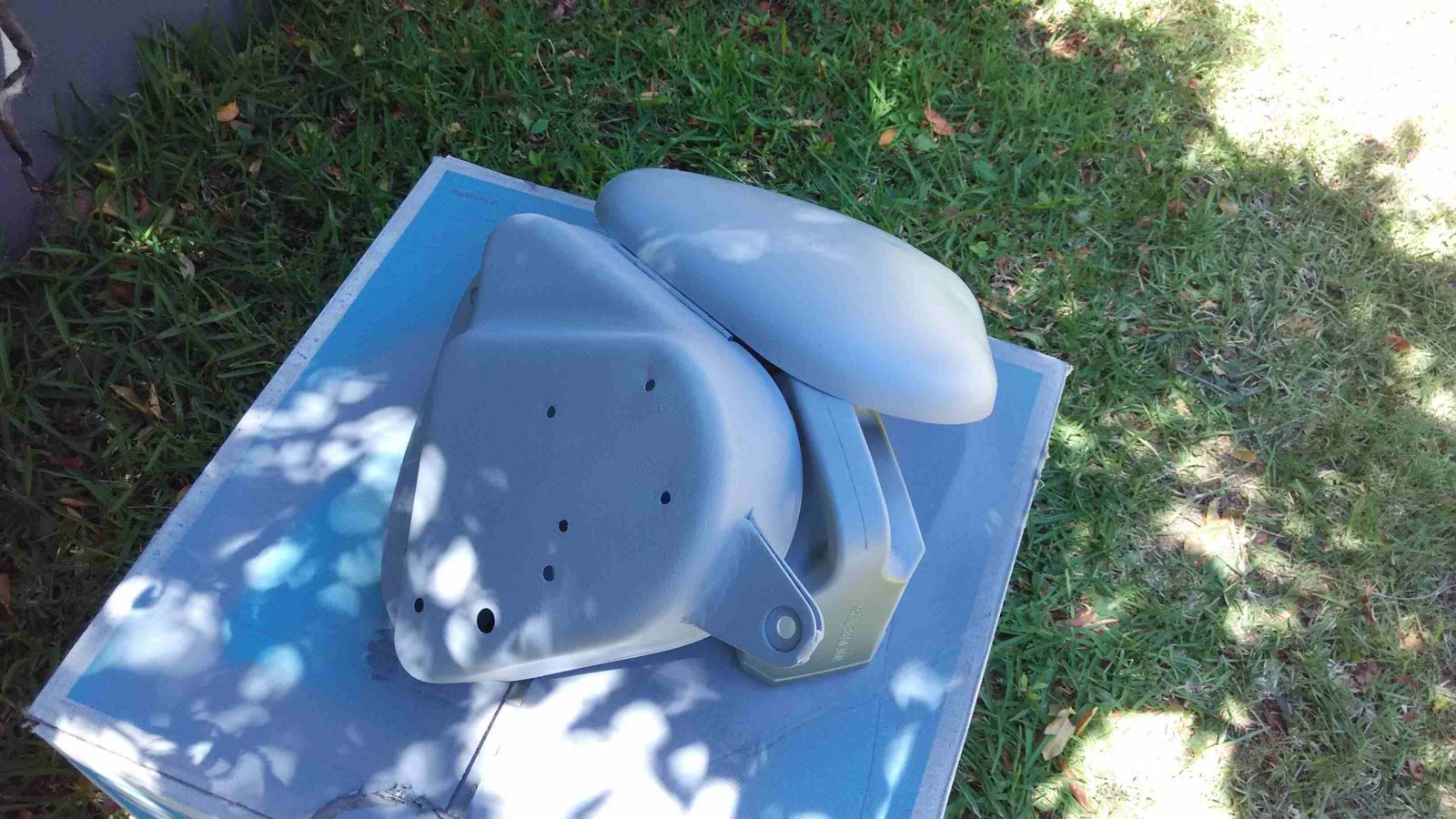
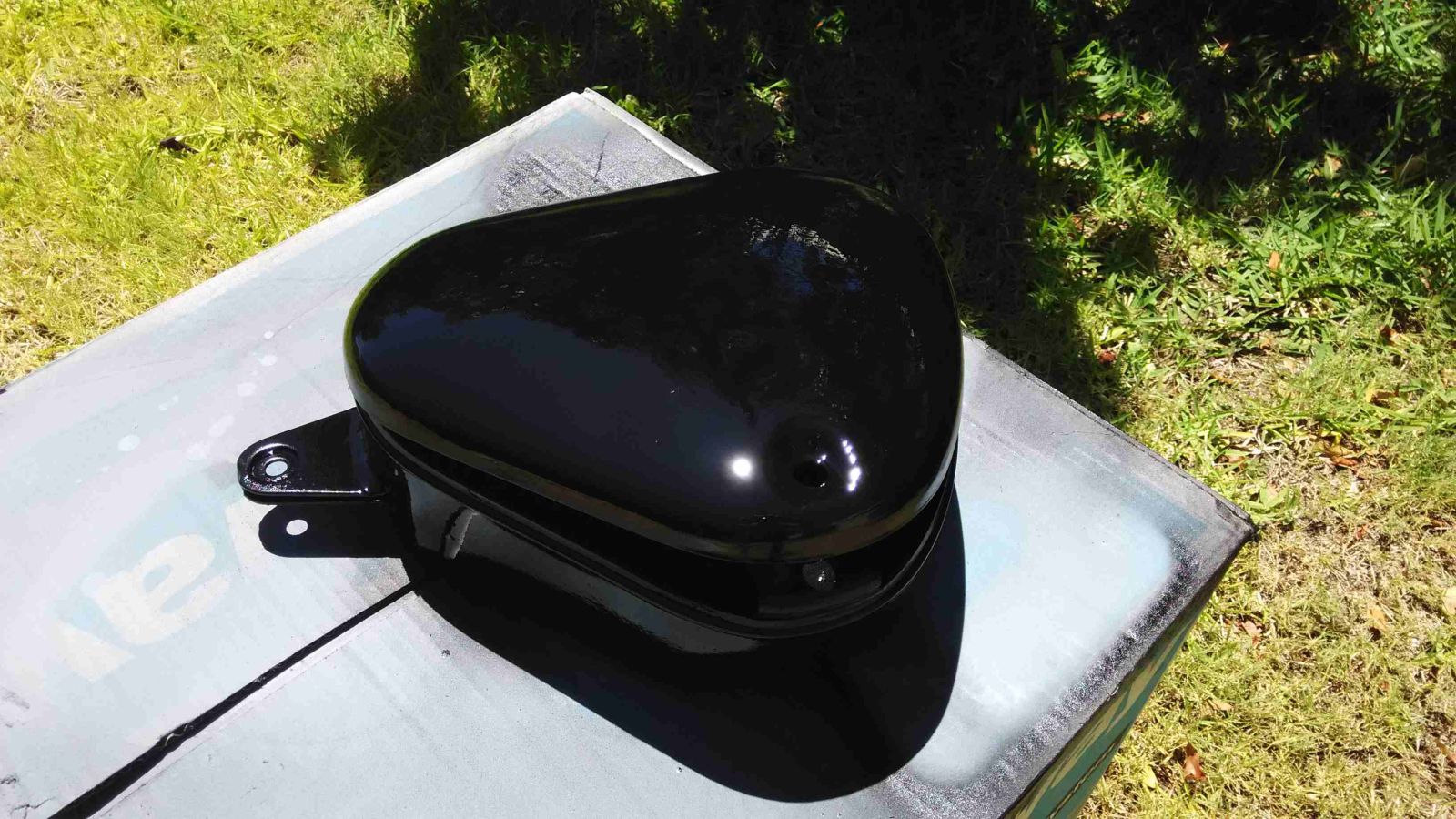
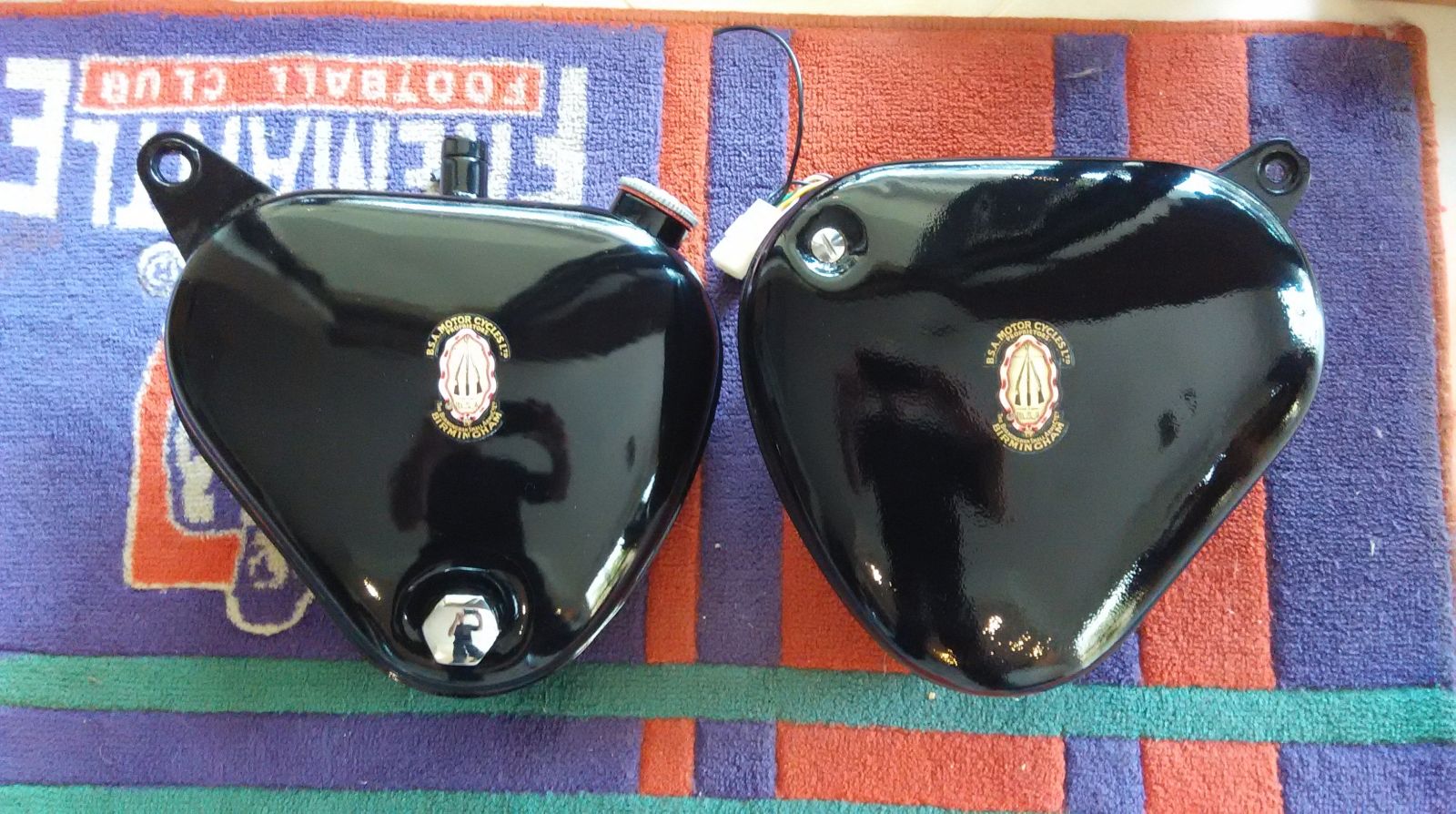
That tool box had sat on that bike for 40 years and had bad chrome with rust pitting under it, rust inside.
Evaopo-Rust cleaned it enough for priming and painting.
I also used it on a Triumph Stag bumper (very hard to get, they make replacements which are nowhere near as good as the original) to remove rust from the rear of it before preservation. The outside is chrome, but the inside barely treated, so they rust.
The Evapo-Rust removes the inside surface rust, with no damage to existing chrome.
It is a brilliant product.
AIMS' Note on Safe Use of Lubricants
- Protective gear: Protect your skin and eyes! Wear chemical-resistant gloves to prevent skin irritation or absorption of chemicals. Safety glasses or goggles provide essential eye protection. Additionally, consider using a respirator if fumes are particularly strong or you are working for an extended period.
- Labels and instructions: Before using any product, carefully read the instructions and safety warnings on the label. Follow the specific guidelines for usage, proper handling and disposal. Check for ‘use by’ dates.
- Fire hazards: Many parts cleaners and lubricants are flammable. Keep them away from open flames, heat sources, and anything that could cause a spark. Store these products in a cool, dry location in their original containers, out of the reach of children and pets.
- Environment: Choose less toxic and environmentally friendly options whenever possible. Make sure there are no open flames or anything that can ignite flammable substances. Dispose of used products and empty containers responsibly according to the instructions or your local hazardous waste guidelines.
- Ventilation: When working with chemicals that release strong fumes, always work in a well-ventilated area, preferably outdoors or in an open area. If you are working indoors, make sure that the windows are open and consider using fans to increase airflow and disperse / vent out the fumes.



.png)